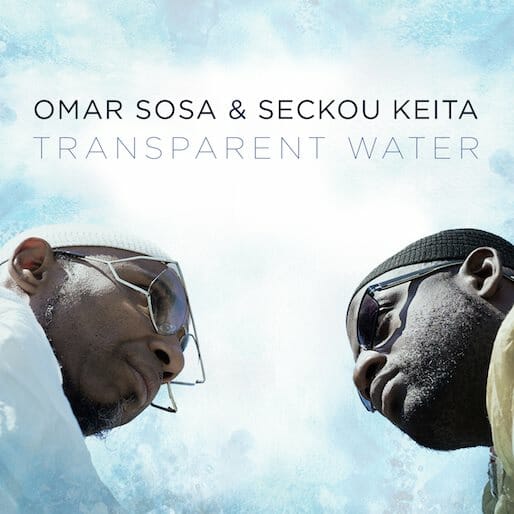
The new album, Transparent Water, from Cuban jazz pianist Omar Sosa is an adventurous foray into world fusion with Seckou Keita. And while the combination of jazz piano and West African kora has been done before, here the point of this collaboration is a deep exploration of tone.
That may seem expected these days, what with the spread of high-concept, world fusion albums like Yo Yo Ma’s Silk Road Ensemble, but it’s an interesting point that both artists here come out of highly rhythmic and virtuosic traditions. The kora, an intricate 21-string harp spread throughout West Africa’s Mandinka empire and beyond, is known for blindingly-fast, cascading runs of notes that defy neophytes to the instrument. And Cuban roots music rolls out from the syncopated clockwork of the clave, a repeated rhythmic framework that compels the body to dance.
Rather than exploring these possibilities, instead these two masters settle into the creation of extended soundscapes based on the purity of each instrument’s sound. As a recording of water flows underneath tracks like “Dary” or “In the Forest,” the kora and the piano spin their way through remarkably beautiful, but ultimately simple melodies. Tracks like “Mining-Nah” hint subtly at the virtuosity of these artists, but nobody here overplays their cards. It’s an album that’s comforting, not challenging, touching on the sadly maligned genre of “New Age World music.”
It almost feels like a lost opportunity. Western African music, and indeed most African music, has long been influenced by Latin and Caribbean traditions in a two-way flow of music and cultural ideas that dates back to the early recording era. The exploration of how Keita’s background in world fusion and Sosa’s cross-cultural jazz explorations might connect could have been a powerful project. But as Latin-jazz-meets-African-roots has also been done before, perhaps the point here is more to show the geniality of two great artists coming together to make something that’s accessible and almost touching at times.
And to show how connected we all are in our modern world, as seen in the wildly disparate group of musicians that Sosa and Keita bring together for the album. Chinese classical musician Wu Tong (of Silk Road Ensemble) joins the group, having met Sosa at a residency in Santiago De Compostela, bringing his proficiency on the Chinese sheng and the bawu, a free-reed flute rarely heard outside of China. Japanese koto artist Mieko Miyazaki comes to the group from her work in the Parisian jazz scene, and Sosa brings longtime collaborator, Venezuelan percussionist Gustavo Ovalles. They even go so far as bringing the arcane nagadi kettle drums from India via percussionist Mosin Khan Kawa and the Korean geomungo via E’Joung Ju. Every guest artist feels like they’ve been selected for the exact tone of their specific instruments, with their talents as master musicians subjugated somewhat to the larger whole.
Each of these very different artists come from deep traditions that border more on classical music than folk, which might account for the rather compositional feel of the work. There’s little emphasis on the improvisation or syncopation you’d expect from Sosa or Keita. Instead everyone is focused on fitting together seamlessly around a melody, often a gentle, sung refrain. It’s a testament to Sosa’s vision that all the different parts and players mesh together so perfectly. The album creates an overall feeling of peace tinged with joy and optimism, something that might actually be more important and necessary in these unsettling times than an overt political statement.